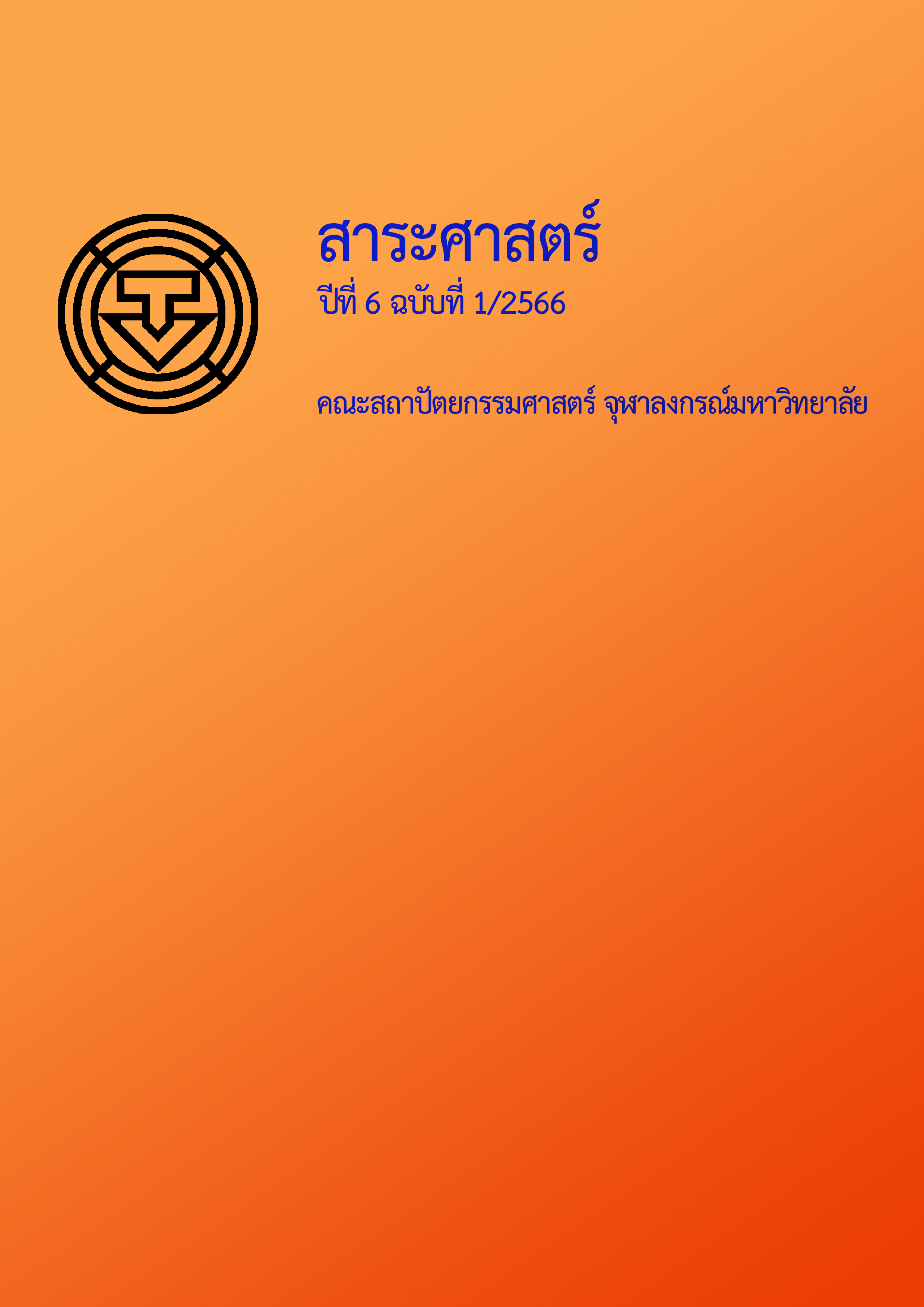Thermal Comfort in Public Space of Santiphap Park, Bangkok
Main Article Content
Abstract
An urban park is an essential part of urban living. It provides physical area for leisure activities as well as urban liveliness and livability. It also contributes to thermal comfort in urban areas. The objective of this research is to study the effects of landscape elements toward thermal comfort in Suntiphap Park in relation to users’ activities. Climate condition of the park in the winter was measured along with surveys of park activities and its physical environment. Interviews were also conducted on park users to measure their satisfactory toward the climate condition. The thermal comfort in each zone of the park was then analyzed. Finally, recommendations on physical improvements through landscape elements were proposed to help increasing thermal comfort in the park.
The results indicated that, in morning hours, users were satisfied with the climate condition and thermal comfort at the time were acceptable, with mean temperature between 27.1 to 30.3°C, relative humidity between 48.9 to 57.7 percent, and wind speed between 0.18 to 0.47 meters per second. In the afternoon, most users reported that the climate condition was acceptable but felt a little bit warm, particularly, in zone A-A, A-C, A-E, A-F, A-G and A-I. The afternoon mean temperature was between 31.9 to 35.2°C, correlating with relative humidity between 36.8% to 45.6 percent and wind speed between 0.10 to 0.66 meters per second. Lastly, in the evening, the climate condition was acceptable for them. However the users reported that they felt a little bit warm leading to the state of discomfort at the moment. The evening mean temperature was between 32.2 to 33.4°C, correlating with relative humidity between 43.5 to 47.6 percent and the wind speed between 0.33 to 0.55 meters per second.
The research concludes that the landscape elements of the park have led the majority of users to be satisfied with the climate condition of the park, although their reported thermal comfort zone ranges 2.5°C higher than the standard thermal comfort zone. However users also experience a slight heat sensation at certain time resulting in a state of discomfort. Therefore, recommendations on physical improvements through landscape elements of zone A-A, A-C, A-E, A-F, A-G and A-I include: (1) adding plants and trees with different heights, by choosing plants with dense canopy that can provide shade or vertical landscaping in areas adjacent to neighboring buildings by opting for a surface material with low heat storage and low reflection of solar radiation (2) arranging seating along path edges and corresponding to shading areas (3) in zone A-G; even though with presence of dense plants and trees, medium-sized plants such as potted plants, shrubs, and small perennials should be added along the paths to help reducing radiation from shade gaps of high-altitude trees; and (4) increasing the operation time of water fountain during the afternoon hours to create humidity around the water area and adding more pergolas with seatings for a better comfort.
Article Details
References
กิจชัย จิตขจรวานิช. (2556). สภาวะน่าสบายของคนท้องถิ่นในเขตที่ราบสูงและทิวเขาตะวันตกยามหนาว : รายงานวิจัยฉบับสมบูรณ์. คณะสถาปัตยกรรมศาสตร์มหาวิทยาลัยศิลปากร.
มนตรี ตั้งศิริมงคล. (2546). ลักษณะขององค์ประกอบภูมิทัศน์เมืองที่มีผลต่อการเปลี่ยนแปลงอุณหภูมิอากาศบริเวณถนน กรณีศึกษา ถนนเจริญราษฏร์ [วิทยานิพนธ์ปริญญามหาบัณฑิต ไม่ได้ตีพิมพ์]. จุฬาลงกรณ์มหาวิทยาลัย.
สุดสวาสดิ์ ศรีสถาปัตย์. (2545). การออกแบบวัสดุพืชพันธุ์และการประหยัดพลังงาน. สำนักพิมพ์แห่งจุฬาลงกรณ์มหาวิทยาลัย.
American Society of Heating Refrigerating and Air Conditioning Engineering. (2004). ANSI/ASHRAE standard 55 - Thermal environmental conditions for human occupancy. The Society.
American Society of Heating Refrigerating and Air Conditioning Engineering. (2017). ANSI/ASHRAE standard 55 - Thermal environmental conditions for human occupancy. The Society.
Busch, J. F. (1992). A tale of two populations: Thermal comfort in air-conditioned and naturally ventilated offices in Thailand. Energy and Building, 18(3-4), 235-249.
De Dear, R. J., & Brager, G. S. (1998). Developing an adaptive model of thermal comfort and Preference. Center for the Built Environment, UC Berkeley.
Humphreys, M., & Nicol, F. (1998). Understanding the adaptive approach to thermal comfort. ASHRAE Transactions, 104(1), 991-1004.
Humphreys Revd, M. A. (1996). Thermal comfort temperatures world-wide - The current position. Renewable Energy, 8(1-4), 139-144.
Mclntyre, D. A. (1980). Indoor climate. Applied Science.
Matzarakis, A., & Rutz, F. (2010). Modelling of mean radiant temperature in urban structures calculation of thermal indices (RayMan Pro Version 3.1) [Software].


